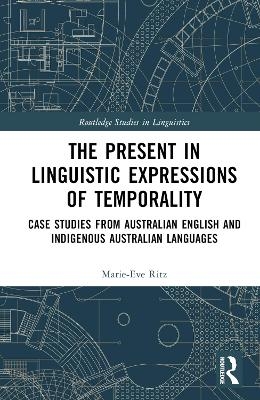
The Present in Linguistic Expressions of Temporality
Routledge (Verlag)
978-0-367-50833-3 (ISBN)
This book offers a comprehensive examination of Present Time Expressions (PTEs), illustrating how a more informed understanding of their semantic and pragmatic representations can offer unique insights into the temporal systems of languages.
The volume takes as its point of departure the notion that tenses, aspectual viewpoint markers, and temporal expressions have a semantic meaning, which is further pragmatically enriched and manipulated in use by speakers. Building on this foundation, the book introduces current theories on the linguistic expression of temporality toward better highlighting the need for further understanding of PTEs, encompassing tenses of the present and words such as ‘now.’ The volume draws on data from Australian English and Indigenous Australian languages to support its goal of arriving at a theory of the flexibility of uses of PTEs and their centrality in language and highlight the implications for future research on pragmatic and semantic change.
This book will be of particular interest to graduate students and researchers in semantics, pragmatics, discourse analysis, and philosophy of language, as well as those interested in research on Indigenous Australian Languages and Australian English.
Marie-Eve Ritz is currently a research fellow at the University of Western Australia, Australia.
Contents, List of Figures, List of Tables, Preface, Acknowledgements, Abbreviations, Chapter 1: Introduction, 1.0 Introduction: goals and motivation for the present study, 1.1 Tense: an overview and brief history of the treatment of tense and of the importance of the Present, 1.2 Outline of the book, Chapter 2: Tense, aspect and adverbials: overview of key semantic and pragmatic theories, 2.0 Introduction, 2.1 Aspect, 2.1.1 Some issues with the Vendlerian categorisation, 2.1.2 Aspectual composition, 2.1.3 The structure of eventualities: aspectual shift and coercion, 2.2 Tense and Aspect in Discourse Representation Theory, 2.2.1 Temporal adverbs and adverbial phrases in DRT, 2.3 The discourse-pragmatics of tense and aspect: temporal inferences of rhetorical relations, 2.4 SDRT: discussion and extensions, 2.5 Conclusion, Chapter 3: The temporal semantics and pragmatics of ‘now’ vs ‘then’: overview of current theories, 3.0 Introduction, 3.1 From now as indexical to now as anaphor, 3.2 Is the sense of contrast part of the semantics of now?, 3.3 Now and temporal progression, 3.4 Now and then in English and cross-linguistically, 3.5 ‘Now’ and ‘then’ in languages other than English, 3.6 Now and then: discourse marking functions, 3.7 Summary and conclusions, Chapter 4 ‘Now’ in absolute and relative uses: case studies, 4.0 Introduction, 4.1 Overview of ‘now/then’ temporal clitics in Australian Indigenous languages, 4.1.1 The clitic =rru in Panyjima, 4.1.2 The clitic =biyang in Jaminjung, 4.1.3 The clitic =lku in Walpiri and Warlmanpa: typological considerations, 4.2. The clitic =rru in Martuthunira, 4.2.1 The clitic =rru and the Martuthinira TAM system, 4.2.2 Detailed analysis of =rru in Martuthunira, 4.2.2.1 =rru in discourse: rhetorical analysis, 4.2.2.2 =rru and contrast, 4.3 Discussion and conclusion, Chapter 5: Shifted tenses: the Historical Present, 5.0 Introduction, 5.1 Early discussion: the HP as a ‘dramatic or vivid’ tense and the nature of the English Simple Present, 5.2 Do we need a dual context to represent the HP?, 5.3 The role of tense vs aspect and discourse relations, 5.4 The Present: a combination of deictic and relative meaning? The case of ‘double access’ sentences, 5.5 The Narrative/Historical Present and perfectivity: some cross linguistic observations, 5.6 Conclusions and sketch of an alternative proposal, Chapter 6: Present tenses and shifted uses in discourse: case studies, 6.0 Introduction, 6.1 A Narrative Future? Telling a story in Martuthunira, 6.2 The Narrative Present Perfect and the Historical Present: telling a story in Australian English, 6.2.1 The Narrative Present Perfect in two genres, 6.2.2 The Simple Past, the Historical Present and the Narrative Present Perfect: understanding the differences, 6.2.3 Pragmatic effects of shifted present tenses: vividness, evidentiality and mirativity, 6.3 The shifted present domain: discussion, Chapter 7: Towards a theory of the linguistic present, 7.0 Introduction, 7.1 What’s in a ‘now’?, 7.2 What’s in a present?,7.3 Presentness: absolute and relative, 7.4 The pretence, 7.5 Conclusion, Chapter 8: What now?, 8.0 Introduction, 8.1 Deixis, anaphora; relative and absolute tense, 8.2 Empirical testing of speakers’ perceptions of ‘now’ and the present time, 8.3 Emprical studies of figurative language use, 8.4 Concluding: further research
| Erscheinungsdatum | 05.12.2023 |
|---|---|
| Reihe/Serie | Routledge Studies in Linguistics |
| Zusatzinfo | 6 Tables, black and white; 19 Line drawings, black and white; 19 Illustrations, black and white |
| Verlagsort | London |
| Sprache | englisch |
| Maße | 152 x 229 mm |
| Gewicht | 639 g |
| Themenwelt | Geisteswissenschaften ► Sprach- / Literaturwissenschaft ► Anglistik / Amerikanistik |
| Geisteswissenschaften ► Sprach- / Literaturwissenschaft ► Literaturwissenschaft | |
| Geisteswissenschaften ► Sprach- / Literaturwissenschaft ► Sprachwissenschaft | |
| ISBN-10 | 0-367-50833-8 / 0367508338 |
| ISBN-13 | 978-0-367-50833-3 / 9780367508333 |
| Zustand | Neuware |
| Haben Sie eine Frage zum Produkt? |
aus dem Bereich


